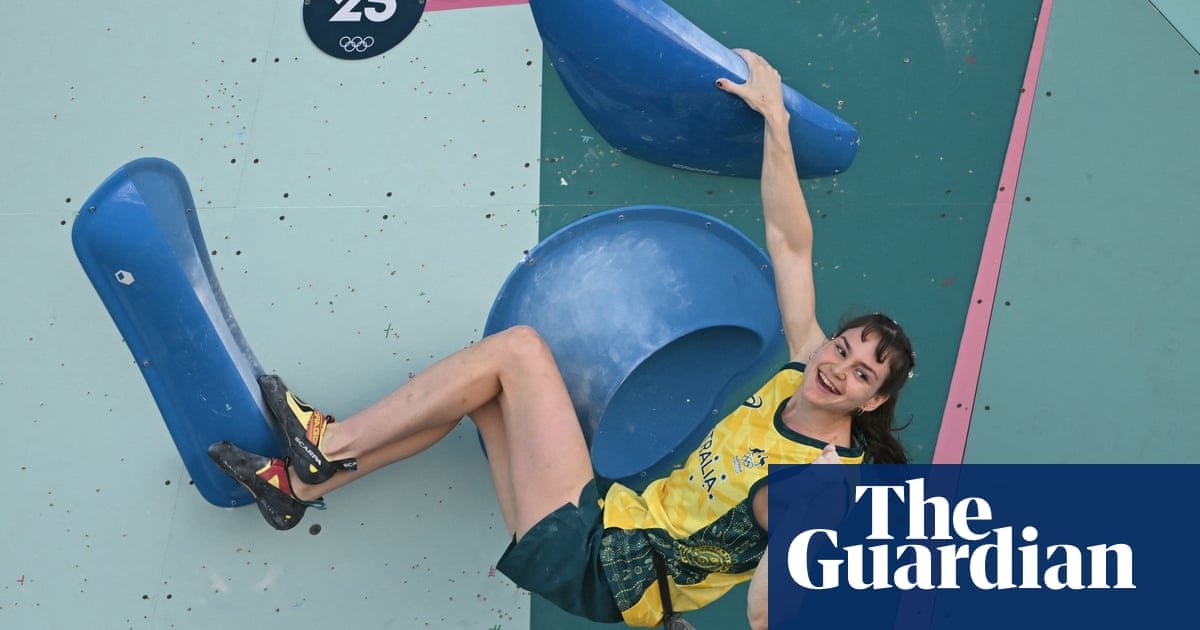Oceana Mackenzie enters the arena and faces the first “problem” she must overcome, a daunting four-and a-half metre wall studded with a seemingly-random smattering of protrusions. Bouldering, a sub-discipline of sport climbing, requires an intriguing combination of gymnastic strength and mental acuity. Mackenzie, a 22-year-old from Melbourne, must make it up the wall in as few attempts as possible.
Climbers face their problems, as each climbing course is called, blind; the arrangement of boulders on a wall is always changing, with “route setters” finding new ways to challenge the athletes. Before a heat, climbers are segregated in an isolation room so they cannot watch the attempts of earlier competitors on that day’s problems. So when Mackenzie walks onto the stage, before a jovial 6,000 crowd on a sunny Tuesday morning in an outer suburb of Paris, her first task is in the mind – drawing on years of climbing experience to determine the optimal route to the top.
Fortunately, the problem ahead of her was good news. Mackenzie took a brief, quizzical look at wall, head cocked to the side as she took it in, before dusting her hands with chalk. And then she went – one hand here, another foot there, an outstretched arm over there – clambering up the face of the wall with ease and agility. Bouldering is scored with five segments on the wall each worth five points. Reach the top and a climber is awarded 25 points, with deductions if prior attempts are unsuccessful. The competitors attack four problems across a heat, for a total score out of 100.
Mackenzie reached the first point-scoring position, and then the second. Before the crowd had a chance to take it all in, she was already at the top of the problem. Climbers have five minutes per wall; the Australian had taken just 30 seconds. It was the first perfect score of the day. Perhaps in a nod to Mackenzie’s nationality, the venue DJ had soundtracked her climb to a remix by Australian artist Dom Dolla.
“I went out to the first boulder actually feeling quite nervous,” Mackenzie said afterwards. “But I saw that it was quite my style and was feeling confident and determined and knew that if I just went at it I could ‘flash it’ – do it on my first try – and from then on I was feeling pretty good.”
Sport climbing was added to the program for Tokyo 2020, where Mackenzie finished 19th. But like many newer sports, climbing’s addition to the Olympic roster has endured some teething problems.
There are three distinct subcategories in the sport: bouldering (where athletes are not roped, and so fall to the ground in the event of a mishap), lead (where climbers have a single six minute attempt to go as high as possible on a 15 metre wall) and speed – a race against the clock up a 15 metre wall with an slight incline (the world’s best can reach the top in less than six seconds).
In Tokyo, all three were combined – despite each requiring a very different skill set. Imagine making 100m sprinters also do high-jump and the 1,500m race. For Paris, following some grumbling within the sport, speed climbing was split into its own event – although lead and bouldering remain integrated.
As a spectator, bouldering requires some attention – at any one time there are four climbers working through the four distinct problems simultaneously. When the buzzer sounds after five minutes, volunteers use large poles to scrub the boulders with chalk, before another four athletes emerge. It’s frenetic – there is always someone on the wall, or standing back pondering options, or falling dramatically to the padded floor.
After her successful first problem, Mackenzie has a five minute break. She sticks on her head-phones and cranks some Korean pop tunes (Stray Kids). “I was really vibing, it was a good time,” she said. She looks down at her nails, painted with Aboriginal flags, and then prepares for problem two.
after newsletter promotion
In theory, the problems progress from easiest to hardest, although the first problem had been perplexing competitors; Mackenzie was one of only two to score a perfect 25 on the opening wall. But the second problem only causes slightly more difficultly for the Australian. She almost made the first attempt, leaping towards the top point on the wall but just unable to hang on – free-falling to the mat. But after adding some chalk, and spending some time admiring the wall, Mackenzie is quickly back up, for a near-perfect 24.9.
The third problem was trickier still – requiring some elaborate repositioning and then careful movement to reach the final section. After coming unstuck on two attempts, Mackenzie finally nails it on the third – for another near-perfect score, 24.8. The fourth problem ultimately gets the better of the Australian, only reaching the first segment for a 4.9. But her overall score is enough for fourth place overall, leaving Mackenzie well-placed to qualify for the final, with the lead event on Thursday morning remaining.
Part mental puzzle, part physical challenge, sport climbing is an engaging new addition to the Olympic program. “It’s a combination of things because you have many challenges on the wall – flexibility for one,” Mackenzie says, with a nod to her three strained attempts to reach the final segment on the third problem. “Strength, also having a really strong mind and being really confident in a bouldering round, can really help out a lot. You have to be a very well-rounded athlete.”
